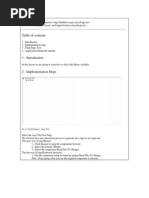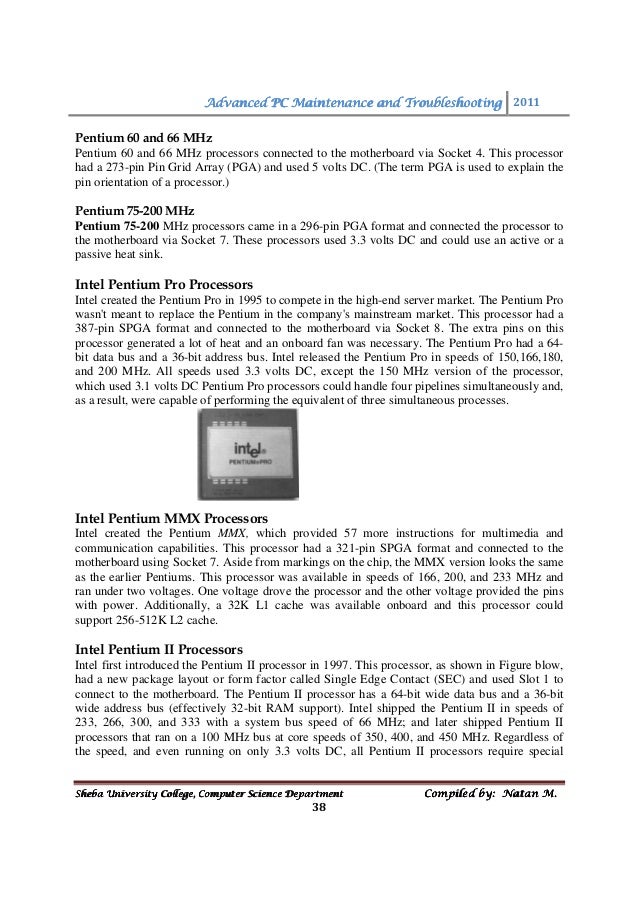Pc Maintenance And Troubleshooting Pdf


Basics of Preventive Maintenance and Troubleshooting. PC Hardware and Software Companion Guide. Chapter 4: Basics of Preventive Maintenance and Troubleshooting 107. Regular maintenance routines reduce computer downtime and repair costs. Chapter 4: Basics of Preventive Maintenance and Troubleshooting 107.
PC Repair and Maintenance: A Practical Guide is a reader-friendly guide to repairing computers (running either Microsoft Windows 95, 98, Me, 2000, or XP) through easy-to-understand language, detailed diagrams, and video tutorials. The book emphasizes that a deep understanding of 'how a computer works' is not necessary to diagnose and repair problems; it concentrates on practical, 'hands-on' solutions that can be implemented right away.
Focusing mainly on installing and troubleshooting hardware, the book also provides solutions to common operating system-related problems. In addition, thorough explanations for selecting re-placement and expansion components without paying top dollar are providedhelping users get the most out of their newly repaired PC. Regardless of your level of experience, this is the perfect resource for anyone who wants to repair a computer or is considering a career in the computer repair business.
Troubleshooting Do you know what to do if your screen goes blank? What if you can't seem to close an application, or can't hear any sound from your speakers? Whenever you have a problem with your computer, don't panic! There are many basic troubleshooting techniques you can use to fix issues like this. In this lesson, we'll show you some simple things to try when troubleshooting, as well as how to solve common problems you may encounter. General tips to keep in mind There are many different things that could cause a problem with your computer. No matter what's causing the issue, troubleshooting will always be a process of trial and error—in some cases, you may need to use several different approaches before you can find a solution; other problems may be easy to fix.
We recommend starting by using the following tips. • Write down your steps: Once you start troubleshooting, you may want to write down each step you take. This way, you'll be able to remember exactly what you've done and can avoid repeating the same mistakes. If you end up asking other people for help, it will be much easier if they know exactly what you've tried already. The Avalanches When I Met You. • Take notes about error messages: If your computer gives you an error message, be sure to write down as much information as possible. You may be able to use this information later to find out if other people are having the same error.
• Always check the cables: If you're having trouble with a specific piece of computer hardware, such as your monitor or keyboard, an easy first step is to check all related cables to make sure they're properly connected. • Restart the computer: When all else fails, restarting the computer is a good thing to try. This can solve a lot of basic issues you may experience with your computer. Using the process of elimination If you're having an issue with your computer, you may be able to find out what's wrong using the process of elimination. This means you'll make a list of things that could be causing the problem and then test them out one by one to eliminate them. Once you've identified the source of your computer issue, it will be easier to find a solution. Scenario: Let's say you're trying to print out invitations for a birthday party, but the printer won't print.
You have some ideas about what could be causing this, so you go through them one by one to see if you can eliminate any possible causes. First, you check the printer to see that it's turned on and plugged in to the surge protector. It is, so that's not the issue. Next, you check to make sure the printer's ink cartridge still has ink and that there is paper loaded in the paper tray. Things look good in both cases, so you know the issue has nothing to do with ink or paper. Now you want to make sure the printer and computer are communicating correctly.
If you recently downloaded an update to your operating system, it might interfere with the printer. But you know there haven't been any recent updates and the printer was working yesterday, so you'll have to look elsewhere. You check the printer's USB cord and find that it's not plugged in.
You must have unplugged it accidentally when you plugged something else into the computer earlier. Java Httpclient File Example Linux. Once you plug in the USB cord, the printer starts working again. It looks like this printer issue is solved! This is just one example of an issue you might encounter while using a computer. In the rest of this lesson, we'll talk about other common computer problems and some ways to solve them.